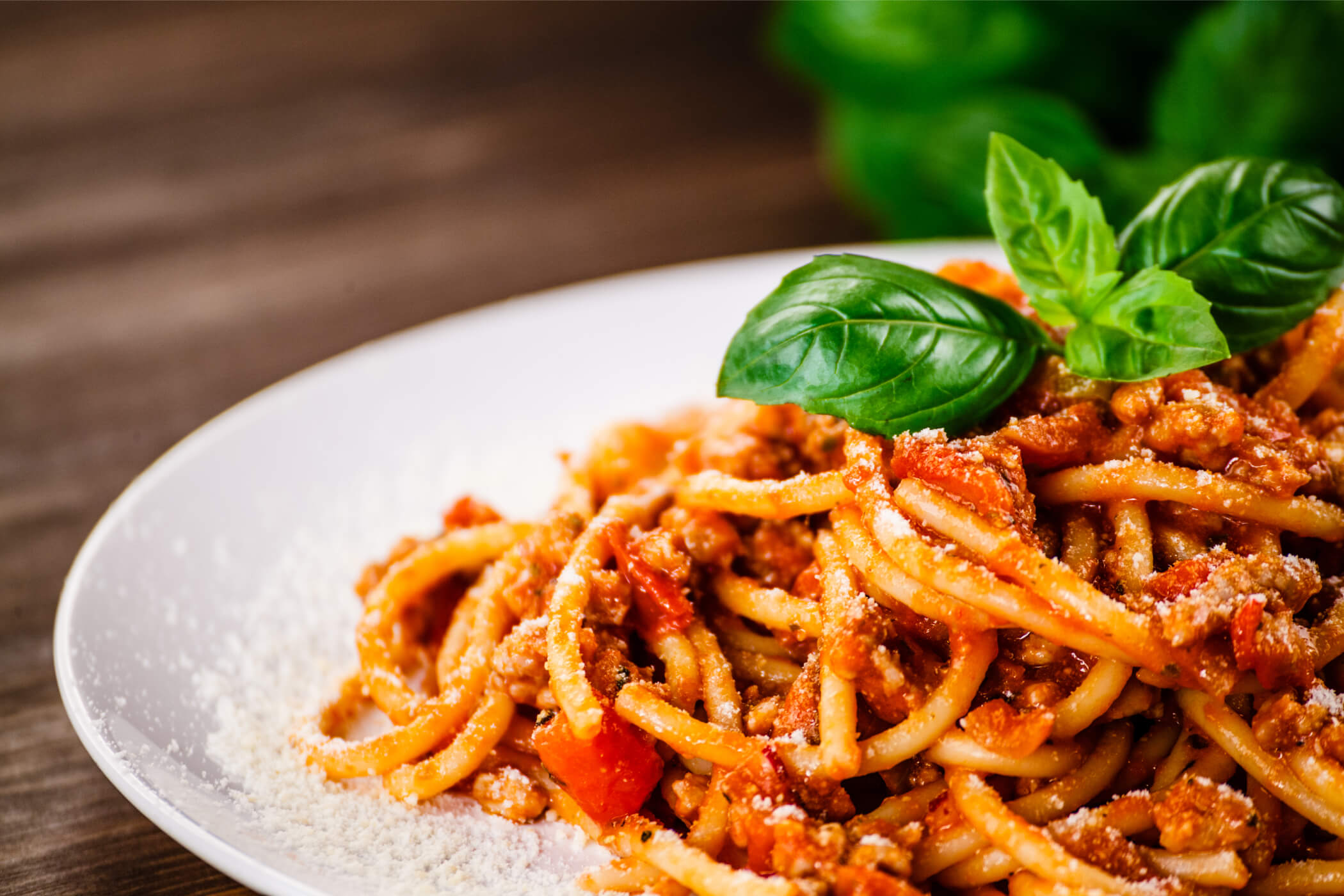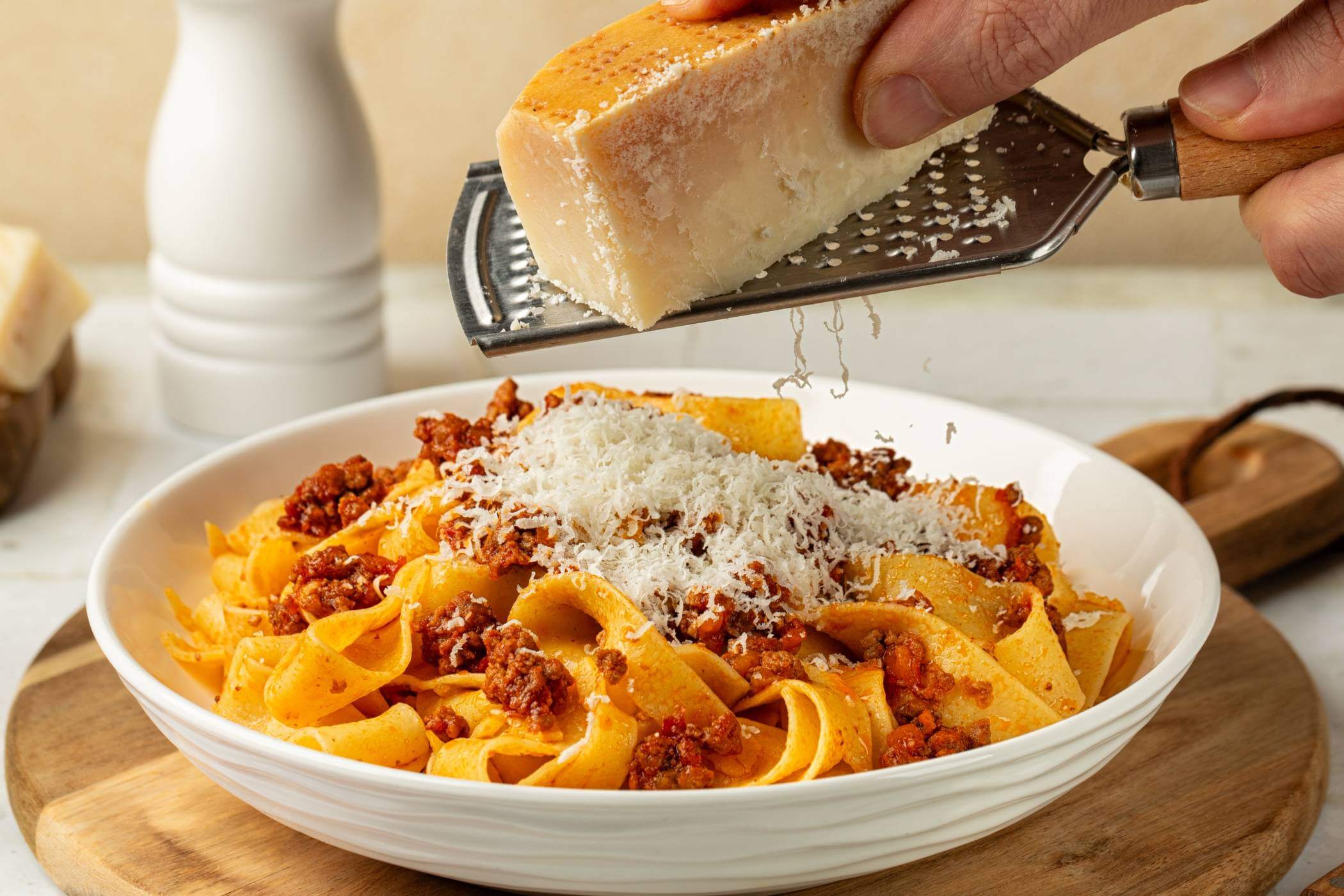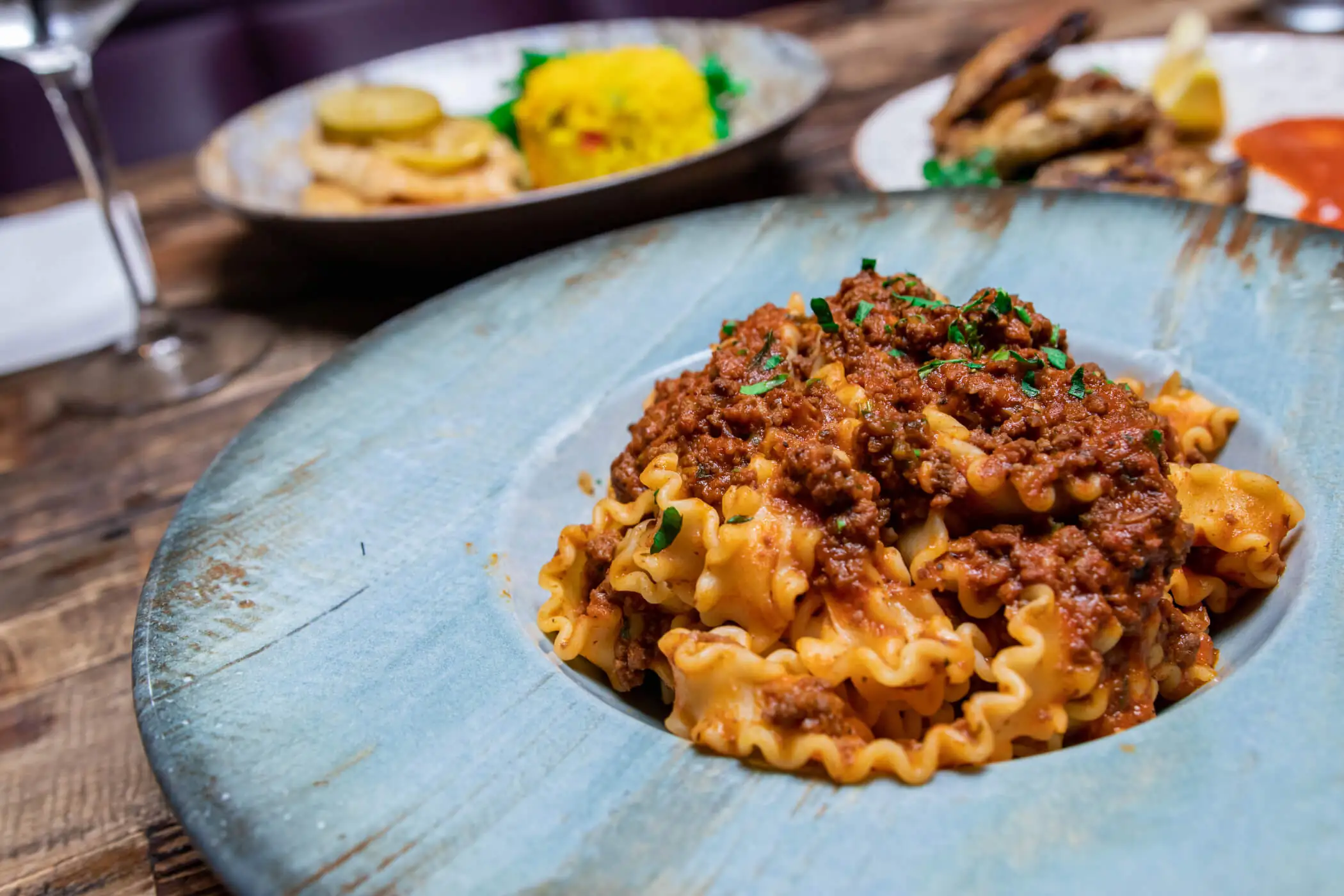Italian cuisine is known worldwide for its bold flavours, fresh ingredients, and rich history; from pizza to gelato, there are countless Italian dishes that have captured the hearts (and stomachs) of people all over the world! But there’s one dish in particular that holds a special place in many people’s hearts: spaghetti bolognese.
Rich, hearty and with a slightly sweet flavour profile, bolognese remains a signature dish at our Italian restaurants in Milton Keynes and Northamptonshire. Want to try your hand at making it at home? Let us guide you through how to make spaghetti bolognese that’ll have your guests asking for seconds!
How To Make Spaghetti Bolognese At Home
While the recipe that we know and love traditionally includes minced beef, there are also vegetarian and vegan variations that are equally as delicious, which is just one of the things that makes this versatile dish so popular! In this article, we’ll provide our step-by-step guide on making spaghetti bolognese, including a traditional recipe and a vegetarian variation, as well as answer some of the most popular spag bol questions!
Can’t get enough?
Join our mailing list for exclusive discounts, new recipes and much more!
Traditional Spaghetti Bolognese Recipe
We know it’s not always easy to pop down to our restaurants in Newport Pagnell, Wolverton or Wellingborough, but that doesn’t mean you can’t enjoy this delicious dish from the comfort of your home. In its simplest form, this mouth-watering meal consists of spaghetti pasta with a meaty tomato-based sauce, but trust us – it is really so much more than that! To begin, though, let’s go back to basics; to make traditional spaghetti bolognese, you’ll need the following ingredients:
- 500g of beef mince
- 1 onion, finely chopped
- 2 garlic cloves, minced
- 1 can of chopped tomatoes
- 2 tablespoons of tomato paste
- 1 teaspoon of dried oregano
- Salt and pepper, to taste
- 500g of spaghetti
To begin, heat some olive oil in a large pan over medium heat. Add the onion and garlic and sauté until fragrant (about 2-3 minutes). Then, add the beef mince and cook until browned, breaking it up into small pieces as it cooks and draining any excess fat.
Next, add your chopped tomatoes, tomato paste, oregano, salt, and pepper to the pan. Stir everything together and let it simmer for about 20-30 minutes, or until the sauce thickens.
While the sauce is simmering, cook the spaghetti according to the package instructions. It is so important to cook your pasta perfectly, and although it may seem simple, sometimes it can be challenging to know the right time to take it out of the water – this helpful guide from BBC Good Food tells you everything you need to know. Drain your pasta and serve with the meat sauce on top!
Vegetarian Spaghetti Bolognese Recipe
If you’re a vegetarian or are simply looking for a meat-free alternative to the classic spaghetti bolognese recipe, you’re in luck! Plenty of delicious vegetarian versions of this Italian favourite are just as satisfying and flavourful – in fact, some people argue that vegetarian spaghetti bolognese is better than the traditional dish, as not adding meat allows the rich flavours of the other ingredients to come through and offers a healthier, plant-based option.
So, whether you’re a vegetarian or are just looking to switch up your usual spaghetti bolognese recipe, this one is definitely worth a try! It is mushroom based, though, so if mushrooms are something that you also aren’t too keen on, you can give this lentil based recipe a go instead, or watch the below video that explains how to make vegan minced beef! To make a vegetarian version of spaghetti bolognese, you’ll need the following ingredients:
- 1 onion, finely chopped
- 2 garlic cloves, minced
- 200g of mushrooms, finely chopped
- 1 can of chopped tomatoes
- 2 tablespoons of tomato paste
- 1 teaspoon of dried oregano
- Salt and pepper, to taste
- 500g of spaghetti
The great thing about a vegetarian bolognese is that you only have to make one substitution, which means you can still enjoy the authentic ingredients and flavours of a traditional bolognese, just without the meat. So, to make your meal, all you have to do is follow the recipe for traditional bolognese, but skip the part that mentions adding the beef.
Instead, once you have sautéd your onions and garlic, add your mushrooms and cook them until they are soft and tender, which is usually about 5-7 minutes.
After this, you can continue with the recipe as it’s written, adding the rest of your ingredients and cooking your pasta before serving it up to give your tastebuds a treat!
Our Top Tips
Now that we’ve got the recipes out of the way, it’s time to talk about the all-important little things that make a big difference in your spaghetti bolognese. These tips and tricks come from years of experience cooking and eating this beloved Italian dish, and are sure to take your spaghetti bolognese to the next level.
From the type of meat to use, to the cooking time and techniques, our top tips will help you create a spaghetti bolognese that’s bursting with flavour and texture. So take some notes, and get ready to impress your friends and family with your newfound spaghetti bolognese skills!
- What Meat Is Best In Spaghetti Bolognese?
- What Dried Herbs Go In Spaghetti Bolognese?
- How Long To Cook Spaghetti Bolognese?
- Can You Cook Spaghetti Bolognese In A Slow Cooker?
- What Cheese Do You Put On Spaghetti Bolognese?
- Can You Freeze Spaghetti Bolognese?
- Can You Reheat Spaghetti Bolognese?
- How Long Can Spaghetti Bolognese Last In The Fridge
View this post on Instagram
What Meat Is Best In Spaghetti Bolognese?
One thing that goes without saying, the meat you use in your spaghetti bolognese is critical to the dish’s success. While minced beef is the most traditional choice, using a combination of beef and pork can add depth and complexity to the flavours. In Italy, we often use a mix of minced veal, beef, and pork to create a rich and extremely satisfying bolognese sauce.
If you’re looking for a healthier option, ground turkey or chicken are great alternatives due to the fact they’re lower in fat and calories than beef or pork but still provide a delicious protein source. We recommend using a mix of white and dark meat when using poultry to give your bolognese a well-rounded flavour.
When it comes down to it, the meat you choose to use for your bolognese is a matter of personal preference; however, experimenting with different meat blends will help you find the perfect balance of flavour and texture because, as we mentioned earlier, everyone has their own idea of a perfect bolognese.
What Dried Herbs Go In Spaghetti Bolognese?
One of the great things about spaghetti bolognese is that you can afford to get a bit experimental. Traditionally, dried herbs like oregano, basil and thyme would be included in spaghetti bolognese. However, sometimes, if we’re in the mood for a deeper flavour profile, we’ll include some sage and rosemary, too.
How Long To Cook Spaghetti Bolognese?
From our experience, we can tell you that the cooking time for spaghetti bolognese varies depending on the recipe and personal preference. However, to get the best flavour, it’s important to simmer the sauce for at least 20-30 minutes. This allows the flavours to blend together and intensify, resulting in that rich and delicious sauce that perfectly coats the spaghetti.
Keep in mind that if you’re using tougher cuts of meat or vegetables, you may need to simmer the sauce for even longer to ensure they are fully cooked and tender. So be patient, and let the sauce simmer away on the hob while you prepare the pasta. Trust us, it will be worth the wait!

Can You Cook Spaghetti Bolognese In A Slow Cooker?
It is definitely not the first method that comes to mind, but cooking spaghetti bolognese in a slow cooker is a great way to achieve a delicious, hearty meal without spending too much time in the kitchen, and we highly recommend giving this method a go. All you have to do is brown the mince in a pan to give it a nice flavour and texture before transferring it to the slow cooker along with all the other ingredients. Let the slow cooker work its magic on low for 6-8 hours or on high for 3-4 hours.
What Cheese Do You Put On Spaghetti Bolognese?
Cheese is an essential ingredient when it comes to serving up a perfect plate of spaghetti bolognese; think of it like the cherry on top of a sundae. Traditionally, parmesan cheese is most commonly used for this dish, as its nutty, salty flavour pairs perfectly with the rich tomato sauce. However, if you’re feeling adventurous, you can also experiment with other hard cheeses like Pecorino Romano or Asiago, which offer a slightly different flavour profile.
To serve, simply grate the cheese over the top of the pasta with a fine grater before serving, allowing it to melt and mix with the sauce. This a simple but essential step that will take your spaghetti bolognese to the next level. So don’t be afraid to get creative and try out different types of cheese to find your perfect combination.

Can You Freeze Spaghetti Bolognese?
Freezing spaghetti bolognese is a great way to save time and make meal planning easier. It’s also a convenient option if you have leftovers you don’t want to waste. However, there are a few things to keep in mind when freezing spaghetti bolognese to ensure the best possible results.
First of all, it’s very important you let the spaghetti bolognese cool completely before you put it in the freezer to prevent the formation of ice crystals and ensure that the distinctive textures and flavours of the dish remain intact. Once it’s cooled, transfer the spaghetti bolognese to an airtight container, making sure to leave some room at the top for expansion; you can also freeze it in individual portions for easy reheating later. Spaghetti bolognese can be frozen safely for up to 3 months, so with just a little bit of planning and proper storage, you can enjoy your delicious homemade dish even on your busiest days.
Can You Reheat Spaghetti Bolognese?
When you’re ready to eat your frozen portions, transfer the container to the fridge and let it defrost overnight. This will ensure that the dish thaws evenly and safely. Alternatively, you can defrost it in the microwave on a low power setting, stirring occasionally.
Once your spaghetti bolognese is defrosted, you can reheat it either on the hob or in the microwave (we prefer to do it on the hob, but we understand sometimes it is just too good to wait!). To reheat on the hob, transfer the spaghetti bolognese to a saucepan and cook over a medium heat, stirring occasionally, until it’s heated throughout. If it’s too thick, you can add a splash of water, broth, or even red wine to thin it out. To reheat in the microwave, transfer the spaghetti bolognese to a microwave-safe dish and cover loosely with a lid or microwave-safe wrap. Cook on high for 1-2 minutes, stirring occasionally, until it’s heated thoroughly.
How Long Can Spaghetti Bolognese Last In The Fridge
According to Cooktop Cove, you can safely store spaghetti bolognese in the fridge for 3-5 days. Make sure you let it cool before putting it in the fridge as placing hot foods in the fridge may harm the quality of the other food being stored there. If you leave your spaghetti bolognese in the fridge for too long, bacteria may begin to form, and you risk illness.

The Dish That Stands The Test Of Time
And there you have it! Our ultimate guide to cooking the best spaghetti bolognese is finally complete. As Italians, we believe this dish is not just a meal but a representation of our culture and heritage. It’s a comforting and hearty dish passed down through generations, each with its unique take on the recipe.
Whether you prefer a meaty or vegetarian version, there is always a recipe out there that will tantalise your taste buds, and by following our tips and tricks, you’ll be able to make a heavenly spaghetti bolognese every time.
But why stop there? We think it’s time for you to put on your apron, grab some fresh ingredients, and start cooking up a storm in your kitchen. And if you’re ever in the mood for an authentic Italian experience, why not visit our restaurant in Newport Pagnell, Wellingborough or Wolverton? We promise to treat you like part of our family and serve you only the best authentic Italian cuisine. Buon appetito!
Fancy paying us a visit?
Submit your enquiry here, and we’ll be in touch!
